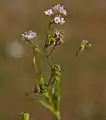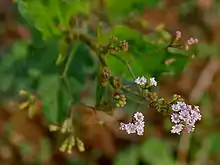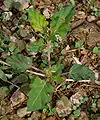Boerhavia
Boerhaavia is a genus of over 100 species in the four o'clock flower family, Nyctaginaceae.[1] Some species are annuals and others perennials. In habit they generally are herbaceous.
| Boerhavia | |
|---|---|
 | |
| Boerhavia diffusa | |
| Scientific classification | |
| Kingdom: | Plantae |
| Clade: | Tracheophytes |
| Clade: | Angiosperms |
| Clade: | Eudicots |
| Order: | Caryophyllales |
| Family: | Nyctaginaceae |
| Tribe: | Nyctagineae |
| Genus: | Boerhavia L. |
| Species | |
|
See text | |
| Wikimedia Commons has media related to Boerhavia. |
Common names include spiderlings and hogweeds. "Spiderling" refers to the appearance of those species that bear inflorescences on numerous long, slender stems, interlocking in a manner suggestive of a spider or spider's web.
The genus was named for Herman Boerhaave, a Dutch botanist, and the genus name is frequently misspelled "Boerhaavia".
Boerhavia species generally are native to warm tropical regions.
Selected species
- Boerhavia anisophylla Torr. – wineflower
- Boerhavia boissieri
- Boerhavia coccinea P.Mill. – scarlet spiderling
- Boerhavia coulteri (Hook.f.) S.Wats. - Coulter spiderling, Coulter's spiderling
- Boerhavia diffusa L. – red spiderling
- Boerhavia dominii Meikle & Hewson – tah-vine
- Boerhavia elegans
- Boerhavia erecta L. – erect spiderling
- Boerhavia gracillima Heimerl – slim-stalk spiderling, slimstalk spiderling
- Boerhavia herbstii Fosberg – alena
- Boerhavia intermedia M.E.Jones – five-wing spiderling, fivewing spiderling
- Boerhavia linearifolia Gray – narrowleaf spiderling
- Boerhavia mathisiana F.B.Jones – Mathis' spiderling
- Boerhavia megaptera Standl. – annual spiderling, Tucson Mountain spiderling
- Boerhavia pterocarpa S.Wats. – Apache Pass spiderling
- Boerhavia purpurascens Gray – purple spiderling
- Boerhavia repens L.
- Boerhavia scandens L. – climbing spiderling, climbing wartclub, wishbone vine
- Boerhavia spicata Choisy – creeping spiderling
- Boerhavia triquetra S.Wats. – slender spiderling
- Boerhavia wrightii Gray – Wright's boerhavia
Agricultural and horticultural significance
Several species of Boerhavia are of importance as agricultural and horticultural weeds. Some are valued as forage for grazing livestock, and some, such as Boerhavia erecta, also are of use as human food and folk medicine.
Gallery


 B. erecta in Hyderabad
B. erecta in Hyderabad B. erecta in Hyderabad
B. erecta in Hyderabad.jpg.webp)